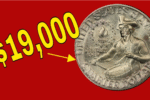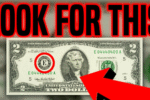Rare $2 bills worth thousands of dollars:Imagine finding a dusty $2 note in an old book or wallet and discovering it’s worth thousands! For collectors and casual hobbyists, rare $2 notes can be hidden treasures. In this post, you’ll learn why some $2 notes are so valuable, how to identify them, and why they’re a hot topic in the world of coin and currency collecting. Let’s dive into the exciting world of valuable $2 notes!
Rare 1953 Red Seal $5 Bills Could Be Worth a Fortune: How to Spot Them
What is a 2 Dollar Bill Worth?
The $2 bill is a piece of American currency that is often overlooked because it is rarely used in everyday transactions. While most $2 notes are worth their face value, some rare notes—due to printing errors, low production or unique serial numbers—can sell for hundreds or thousands at auction. For collectors, finding a valuable $2 note is like striking gold in the coin collecting hobby.
History of The 2 Dollar Note
The $2 note was first issued in 1862, featuring a portrait of Alexander Hamilton. Over time, it went through several designs, including a portrait of Thomas Jefferson from 1869. Production slowed in the 1960s due to low demand, making some series rare. The note’s quirky reputation – often considered “unlucky” or unusual – has added to its allure among collectors.
Major $2 bill series and their features
| Series Year | Portrait | Notable Feature | Approx. Value (Good Condition) |
|---|---|---|---|
| 1890 | Treasury Note | Ornate Red Seal | $500–$2,500 |
| 1928 | Jefferson | Red Seal | $10–$100 |
| 1953 | Jefferson | Star Note | $50–$500 |
| 1976 | Bicentennial | Green Seal | $2–$10 |
Why Are Some 2 Dollar Bills So Valuable Today?
- The value of some $2 bills increases substantially for the following reasons:
- Printing errors: Misprints, missing ink, or double printing are rare and prized.
- Low serial numbers: Bills with serial numbers like “00000001” or repeated digits (e.g., “1111111111”) are collector favorites.
- Star notes: Replacement bills marked with a star (*) in the serial number are rare, especially those of older series.
- Condition: Uncirculated or crisp bills are more valuable than worn bills.
In 2023, a 1953 Star Note in good condition sold for $4,500 at Heritage Auctions, giving an idea of the potential value of these rarities.
How to Identify a Rare $2 Note
Do you want to check if your $2 bill is valuable? Here’s what you should look for:
- Serial number: Look for low numbers, repeated digits or patterns like “12345678” or “12345678” or “11111111.”
- Seal and color: Older bills may have a red or brown seal instead of the modern green seal.
- Star symbol: Check for a star () () in the serial number, which indicates a replacement note.
- Condition: Check for crispness, no tears and vibrant colors.
Use a magnifying glass to look for subtle errors, such as misprints or reversed images. If you think you’ve found a valuable item, consult a professional appraiser or check recent eBay listings for similar bills.
Could Your Wheat Coin be Worth a Fortune? Check out Your Collection Now
Notable Facts About 2 Dollar Notes
- There are over 1.2 billion $2 notes in circulation, but only a fraction of them are collectible.
- The 1976 Bicentennial series, which celebrates 200 years of U.S. independence, is the most common $2 note, but even obsolete sets can be valuable.
- Some collectors look for “ladder” serial numbers (e.g., “12345678”), which can sell for $1,000+.
Features of Common vs. Rare $2 Bills
| Feature | Common $2 Bill | Rare $2 Bill |
|---|---|---|
| Serial Number | Random | Low/Repeating/Ladder |
| Seal Color | Green | Red/Brown |
| Star Note | No | Yes |
| Approx. Value | $2–$5 | $50–$4,500+ |
Expert Tips for Collectors
- Store properly: Keep bills in acid-free sleeves to maintain their condition.
- Research auctions: Sites like Heritage Auctions or eBay show current market values.
- Join communities: Forums like CoinCommunity.com connect you with fellow $2 bill enthusiasts.
- Be patient: Rare bills take time to find — check estate sales, flea markets or old family collections.
- Authenticate: Use a professional grading service like PCGS Currency for high-value bills.
Frequently Asked Questions (FAQ)
Question: Are all old $2 notes valuable?
Answer: No, most notes are worth face value, unless they have rare features like star notes or errors.
Question: Where can I sell rare $2 notes?
Answer: Visit auction houses, eBay, or local coin shops. Always get an appraisal first.
Q: How do I know if my $2 note is a star note?
Answer: Look for a star (*) in the serial number, usually at the beginning or end.
Q: Are $2 notes from 1976 worth more than $2?
Answer: Most notes are worth $2-$5, but obsolete sets or notes with unique serial numbers may fetch higher prices.
Conclusion
Your old $2 bill could be a hidden jackpot waiting to be discovered! By checking for rare features like star notes, low serial numbers or printing errors, you may discover a valuable piece of history. Whether you’re an experienced collector or just curious, start scouring through wallets, drawers or family heirlooms. Share this guide with friends, join the coin collecting community, or check out auction sites to learn more. Cheer up!
also read.




